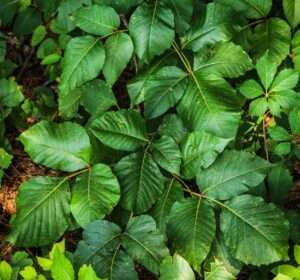Ward Upham
K-State Research and Extension news service
During the growing season, these plants are easy to tell apart as Virginia Creeper has five-leaflets per leaf and Poison Ivy has three. However, during the winter, distinguishing between the two vines can be more difficult as the leaves have dropped. The reason it is important to be able to tell the difference is that Poison Ivy causes a rash in most people but Virginia Creeper does not. First, let’s cover some facts about Poison Ivy.
– Urushiol is the oil present in Poison Ivy that causes the rash.
– Urushiol is present in all parts of the plant but especially in the sap.
– Urushiol can cause a rash from 1 to 5 years after a plant has died.
– The amount of urushiol that covers the head of a pin can cause a rash in 500 people. The stuff is potent.
– Poison Ivy can grow as a ground cover, a shrub or a vine. We are concerned with the vine in this article.
– Using a chainsaw on Poison Ivy in the winter can release sap which makes a rash more likely. This is worse on warm days where there is more sap rise.
So, how do you tell the two apart? This is actually easy once you know what to check. Look at the aerial roots on the vines of Poison Ivy and Virginia Creeper. They resemble hairs on Poison Ivy but are plumper on Virginia Creeper and are about the size of a pencil lead.
Native Plant
Publications
We have information on establishing and maintaining a native plant area on our website. Go to https://hnr.k-state.edu/extension/horticulture-resource-center/publications/ and click on “Native Plants.” It includes a publication from a collaboration among K-State Research and Extension – Douglas County (KSRE), the Grassland Heritage Foundation (GHF), and the Kansas Rural Center (KRC) titled “Planting Natives in Northeast Kansas. Also included is a publication from the Agronomy Department titled “Establishing and Managing Native Prairie Plants in Small Areas.” A native plant list is also provided as well as a publication on developing a small Scale Monarch Butterfly Habitat from the Southwest Research and Extension Center.
Pecan Blog
Dr. William Reid, the Pecan Research and Extension Specialist for Kansas and Missouri for 37 years, has an excellent blog on growing pecans in Kansas and neighboring states. In retirement, Dr. Reid is tending his 30 acre pecan orchard and continues to blog his observations. The blog is titled “Northern Pecans.”
If you are at all interested in pecans, this is a blog you must visit. Excellent photography accompanied by Bill sharing decades worth of experience makes this a gold mine of information. The URL is http://northernpecans.blogspot.com/
Conservation Trees from the Kansas
Forest Service
The Kansas Forest Service offers low-cost tree and shrub seedlings for use in conservation plantings. Plants are one to two years old and sizes vary from 8 to 18 inches, depending on species. Two types of seedlings are offered; bareroot and containerized. Containerized provide a higher survival rate and quicker establishment. Orders are accepted from now through May 1st, but order early to ensure receiving the items you want.
Orders are shipped beginning in mid-March. Approved uses for these plants include windbreaks, wood lots, wildlife habitat, timber plantations and educational and riparian (streambank) plantings. They may not be used for landscape (ornamental) plantings or grown for resale.
All items are sold in units. Each single species unit consists of 25 plants. For example, a unit of Eastern red cedar has 25 trees per unit. Though a single species unit is most commonly purchased, four special bundles are also available including a quail bundle, pheasant bundle, eastern pollinator bundle and western pollinator bundle.
Tree planting accessories are also available including marking flags, root protective slurry, rabbit protective tubes, weed barrier fabric and tree tubes. If there have been problems with deer browsing on young trees, the tree tubes are a must.
For details and an order form, go to: http://kfs.mybigcommerce.com/all-items/ Note that there are three pages of items that are accessed by clickable links at both the top and bottom of the listing. Order forms are also available from local K-State Research and Extension offices.




